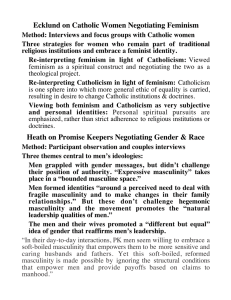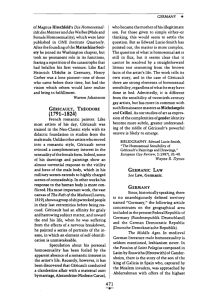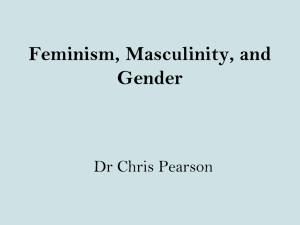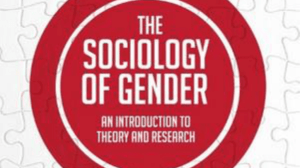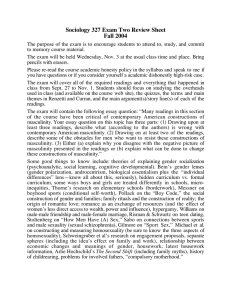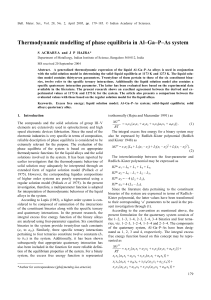Gender and War
advertisement
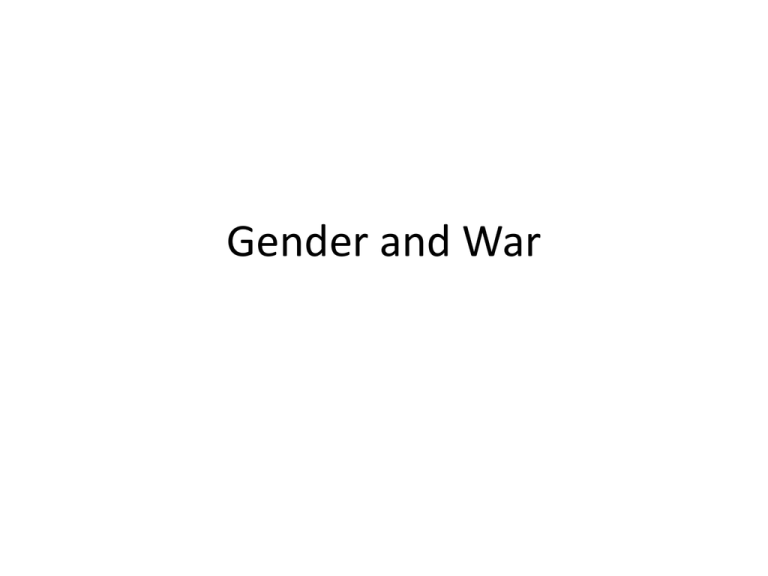
Gender and War Overview • • • • • Introduction Fin-de-siècle gender identities Effects of war Work Conclusion Introduction • The events of 1914–18 crucial reference point for those seeking to understand not only war, but the world • Few would agree with the claim in Paul Fussell’s influential The Great War and Modern Memory that the First World War represented an absolute break with the past • But often seen as crucible of modern world was forged • War crystallised the social, political and cultural changes emerging in the 1890s rather than necessarily acting as an agent of change itself • Samuel Hynes argued that war was an imaginative as well as a military and political event. • Martial hero joined by the coward, the frightened boy, and the shell shock victim Pre-war masculinity • Dominant form under threat from reinterpretations of sexuality • All male homosexual activities outlawed by the Criminal Law Amendment Act of 1885 • Legislators and police viewed homosexuality as a crime. Doctors, psychiatrists, sexologists and psychoanalysts countered this view, arguing that whether homosexuality was congenital or acquired, it was properly the province of science • Weeks argued that the constant debating and the establishment of a legal framework for the ‘control of homosexuality’ all served to encourage the development of distinctive homosexual identities and the quite visible homosexual subcultures. • Sexologists such as Havelock Ellis urged reform, not only of legislation regulating homosexuality but also legislation restricting the rights of especially married women • Backlash eg trials of Oscar Wilde in 1895 and censorship of Sexual Inversion New models of identity and behaviour perhaps typified by Bloomsbury Gp (pictured 1906) and dressed as Abyssinian royals in a hoax played on HMS Dreadnought in 1910 The ‘New’ Woman • This period also witnessed developments in concepts of femininity centred around discussions of the ‘new woman’. • Cartoons in Punch for example, featured powerful and athletic women cycling or playing cricket and bullying effeminate men at cocktail parties • Term first coined in 1894 by the novelist, Sarah Grand referring to women who asserted their entitlement to a public role. • Demands for legal and political rights accompanied by demands for the rights of mothers and for women to control their own bodies through contraception and abortion • Most of those advocating voluntary motherhood supported some eugenic ideas • After the war this was accentuated in the debate on welfare feminism Effects of War • For anti-feminists war was opportunity to restore the natural gender order of warrior versus homemaker • But effects on the social construction of masculinity was ambiguous • For women, their participation, sometimes directly in the war effort, for example as nurses gave them status for the first time as full citizens taking part in the military defence of the nation • Men who did not want to participate in the war were disenfranchised, lost their jobs and were sometimes imprisoned. They were attacked for their lack of patriotism and masculinity. Gender crisis • Men felt themselves emasculated by the horrors of the war experience. • Work of the war poets: Sassoon, Brooke, Owen, Graves etc many of whom died a tragic and early death perhaps represents this bleak realism most effectively. • Many of the men who survived the war ended up maimed or impotent. • Women were seen as the ones who sent men off to war and then benefited from their absence. • Both on the home front and the battlefield women workers were exploited and heavily policed to ensure they behaved appropriately but the images emphasised their new freedoms and added an edge to male hostility. Effects of war • Women who protested against economic hardship were considered a threat to the existing social order • Joanna Bourke concludes: ‘Although historians are divided about the extent to which the war led to any change in the status of women, it is clear that most people in the 1920s believed war had dramatically altered the relationship between the sexes.’ • Is now more recognition that any gains won for women were transitory, limited and temporary. • For men who survived the war family relationships were source of practical survival skills and support • Home and the Western front were not separate spheres, and men’s identities were not split into aspects of the soldier and the civilian Gassed by John Singer Sargent sums up trauma of war Work • Wartime mobilisation of women had little impact on patterns of female employment • In UK in 1951 was smaller percentage of women working than in 1911 • Young women made the transition from domestic service to munitions but did not see factory work as a career, more married women worked but returned to household after war. • Some women may have found work for example in new fields and with wages higher than the previous norm for women, but the numbers were quite small. Year Women entering workforce (000s) Females in workforce (%) 1914-5 382 - 1915-6 563 26.5 1916-7 511 46.9 1917-8 203 46.7 Economic sector All industry Commercial occupations Banking and finance Professional Hotels Transport Civil Service Arsenals (dockyards) Local government Totals July 1914 (000s) July 1916 (000s) Increase between 1914-16 (000s) 2117 2479 362 454 652 198 9.5 39.5 30 67.5 175 15 60 2 82.5 194 46 108 71 15 19 31 48 69 184 212 28 3214 4080 866 Top 10 Occupations for women 1918 Bottom 10 Occupations for women 1918 Hospitals Tailoring and dressmaking Hosiery Teachers Other clothing trades Linen, jute and hemp Tobacco Silk Stationery, cardboard boxes, gum, ink, pencils Textiles Docks and wharves Trams and omnibuses Gas, water and electricity Mines and quarries Building trades Shipbuilding Iron and Steel Other transport Vehicles Railways Women and war work • Sylvia Pankhurst: ‘For women of means the war offered undreamt of activities, opportunities, positions and a great unlocking of their energies’. • Women’s Emergency Corps, Women’s Volunteer Reserves offered women adventurous opportunities • Working class women continued to be exploited in low-paid, monotonous jobs • Some of the voluntary organisations were actively anti-feminist in focus. For example, the Women’s Land Army established by Lady Denman. • Areas of industrial and clerical employment opened up to women during the war. But emphasised that women were temporarily taking men’s jobs • Vast majority of women were still engaged in unpaid family duties • Even the NUWSS established a ‘Patriotic Housekeeping Exhibition’ Post-war • After the war, it was official government policy to deter women from participation in the workplace • Women made to feel guilty if they refused to accept their natural roles as wives and mothers • Women who persisted in taking up a ‘man’s place’ were made the targets of hatred and intimidation • Thousands of women lost their jobs in metal and chemical industries, in construction and engineering, in the civil service and transport and even in waitressing • Women were still visible in the workplace but their participation rates declined and they were concentrated in the lower-level and service sector jobs but domestic servants began to decline rapidly Year Working women as % of all women Single Married Total Women as % of total labour force 1861 - - 42 31 1871 - - 42 31 1881 - - 39 30 1891 - - 38 30 1901 - - 36 29 1911 66 10 37 29 1921 67 9 36 29 1931 70 11 37 30 War and Feminism • Women often had their own agendas which they pursued consistently. • Although the vote was obtained after the war, the ‘gift’ thesis – that women received the vote in return for their war effort has been discredited by historians. • It has been pointed out for example that only women over 30 were given the vote thus excluding the vast majority of women who worked during the war. • The feminist campaign for equal rights before the war was replaced by welfare feminism (to some extent colluding with pro-natalist policies). • In embracing domesticity women were not turning backs on public sphere but sought to construct their own eg WI and townswomen’s guild can be seen as non-political women’s public organisations which developed women’s status in their own communities. Conclusion • Reconstruction after the war included the renegotiation of the place of men and women in public and work contexts. • In 1929, the year after female suffrage was made universal in England, an English journalist wrote: ‘The tide of progress which leaves women with the vote in her hand and scarcely any clothes on her back is ebbing and the sex is returning to the deep, very deep sea of femininity from which her newly-acquired power can be more effectively wielded’ • There was no straightforward economic or political progress for women after the war. • Masculinity remained the axis of political rights and of predominant conceptions of citizenship.
